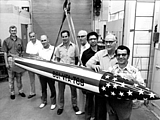 The administration has a new plan: as it prepares for production of the Reliable Replacement Warhead (RRW) to replace most of the nuclear warheads in the operational stockpile, it will “accelerate” dismantlement of retired nuclear warheads to “assure other nations that we are not building up our stockpile.”
The administration has a new plan: as it prepares for production of the Reliable Replacement Warhead (RRW) to replace most of the nuclear warheads in the operational stockpile, it will “accelerate” dismantlement of retired nuclear warheads to “assure other nations that we are not building up our stockpile.”
According to this plan, Deputy Secretary of Energy Clay Cell told the House Energy and Water Subcommittee last week, the DOE will “increase dismantlements planned for FY 07 by nearly 50% compared to FY 06,” and is “committed to increasing average annual warhead dismantlements at the Pantex Plant by 25%.”
Big percentages sound good, but here’s the problem: Since the DOE didn’t plan to dismantle very many warheads in 2007 anyway, increasing the rate by 50% won’t dismantle much either. As congressional and administration sources told the Washington Post, fewer than 100 warheads have been taken apart annually in recent years.
Under the new plan, assuming an increased annual dismantlement rate of 150 warheads, it will take the DOE over 28 years to dismantle the roughly 4,300 warheads it has pledged will be cut from the stockpile by 2012. To meet the deadline, DOE will have to increase the dismantlement rate to more than 700 warheads per year.
What does “accelerated dismantlement” look like? It looks like what we did back in the 1990s, when the United States scrapped some 11,000 nuclear warheads! Since then, the DOE’s priorities have changed from nuclear dismantlement to life-extension of the “enduring” nuclear stockpile. For the next decade, unless Congress or a new administration intervenes, DOE will be busy extending the life of the stockpile rather than dismantling it.
But since an official objective of the administration’s new plan is to “assure other nations,” why not tell them what the warhead numbers are? Why this Cold War nuclear secrecy? The numbers need to be kept secret, the nuclear custodians warn, because if we told other nations how many warheads we dismantle, they might be able to figure out the size of our stockpile, and that would be bad for national security. But how does the administration plan to assure other nations if they cannot be told? While we wait for the administration to figure that out, here is the stockpile number: today, roughly 9,960 warheads; in 2012, nearly 6,000 warheads. Reassured?
Satellite imagery has long served as a tool for observing on-the-ground activity worldwide, and offers especially valuable insights into the operation, development, and physical features related to nuclear technology.
This report outlines a framework relying on “Cooperative Technical Means” for effective arms control verification based on remote sensing, avoiding on-site inspections but maintaining a level of transparency that allows for immediate detection of changes in nuclear posture or a significant build-up above agreed limits.
The grant comes from the Carnegie Corporation of New York (CCNY) to investigate, alongside The British American Security Information Council (BASIC), the associated impact on nuclear stability.
Satellite imagery of RAF Lakenheath reveals new construction of a security perimeter around ten protective aircraft shelters in the designated nuclear area, the latest measure in a series of upgrades as the base prepares for the ability to store U.S. nuclear weapons.